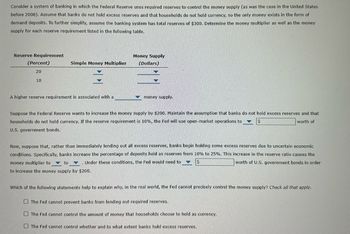
ENGR.ECONOMIC ANALYSIS
14th Edition
ISBN: 9780190931919
Author: NEWNAN
Publisher: Oxford University Press
expand_more
expand_more
format_list_bulleted
Question
Please everything in the photo.

Transcribed Image Text:Consider a system of banking in which the Federal Reserve uses required reserves to control the money supply (as was the case in the United States
before 2008). Assume that banks do not hold excess reserves and that households do not hold currency, so the only money exists in the form of
demand deposits. To further simplify, assume the banking system has total reserves of $300. Determine the money multiplier as well as the money
supply for each reserve requirement listed in the following table.
Reserve Requirement
(Percent)
20
10
Simple Money Multiplier
A higher reserve requirement is associated with a
Money Supply
(Dollars)
money supply.
Suppose the Federal Reserve wants to increase the money supply by $200. Maintain the assumption that banks do not hold excess reserves and that
households do not hold currency. If the reserve requirement is 10%, the Fed will use open-market operations to
worth of
U.S. government bonds.
Now, suppose that, rather than immediately lending out all excess reserves, banks begin holding some excess reserves due to uncertain economic
conditions. Specifically, banks increase the percentage of deposits held as reserves from 10% to 25%. This increase in the reserve ratio causes the
money multiplier to
Under these conditions, the Fed would need to
worth of U.S. government bonds in order
to
to increase the money supply by $200.
Which of the following statements help to explain why, in the real world, the Fed cannot precisely control the money supply? Check all that apply.
The Fed cannot prevent banks from lending out required reserves.
The Fed cannot control the amount of money that households choose to hold as currency.
The Fed cannot control whether and to what extent banks hold excess reserves.
Expert Solution
This question has been solved!
Explore an expertly crafted, step-by-step solution for a thorough understanding of key concepts.
This is a popular solution
Trending nowThis is a popular solution!
Step by stepSolved in 5 steps

Knowledge Booster
Learn more about
Need a deep-dive on the concept behind this application? Look no further. Learn more about this topic, economics and related others by exploring similar questions and additional content below.Similar questions
arrow_back_ios
arrow_forward_ios
Recommended textbooks for you

 Principles of Economics (12th Edition)EconomicsISBN:9780134078779Author:Karl E. Case, Ray C. Fair, Sharon E. OsterPublisher:PEARSON
Principles of Economics (12th Edition)EconomicsISBN:9780134078779Author:Karl E. Case, Ray C. Fair, Sharon E. OsterPublisher:PEARSON Engineering Economy (17th Edition)EconomicsISBN:9780134870069Author:William G. Sullivan, Elin M. Wicks, C. Patrick KoellingPublisher:PEARSON
Engineering Economy (17th Edition)EconomicsISBN:9780134870069Author:William G. Sullivan, Elin M. Wicks, C. Patrick KoellingPublisher:PEARSON Principles of Economics (MindTap Course List)EconomicsISBN:9781305585126Author:N. Gregory MankiwPublisher:Cengage Learning
Principles of Economics (MindTap Course List)EconomicsISBN:9781305585126Author:N. Gregory MankiwPublisher:Cengage Learning Managerial Economics: A Problem Solving ApproachEconomicsISBN:9781337106665Author:Luke M. Froeb, Brian T. McCann, Michael R. Ward, Mike ShorPublisher:Cengage Learning
Managerial Economics: A Problem Solving ApproachEconomicsISBN:9781337106665Author:Luke M. Froeb, Brian T. McCann, Michael R. Ward, Mike ShorPublisher:Cengage Learning Managerial Economics & Business Strategy (Mcgraw-...EconomicsISBN:9781259290619Author:Michael Baye, Jeff PrincePublisher:McGraw-Hill Education
Managerial Economics & Business Strategy (Mcgraw-...EconomicsISBN:9781259290619Author:Michael Baye, Jeff PrincePublisher:McGraw-Hill Education


Principles of Economics (12th Edition)
Economics
ISBN:9780134078779
Author:Karl E. Case, Ray C. Fair, Sharon E. Oster
Publisher:PEARSON

Engineering Economy (17th Edition)
Economics
ISBN:9780134870069
Author:William G. Sullivan, Elin M. Wicks, C. Patrick Koelling
Publisher:PEARSON

Principles of Economics (MindTap Course List)
Economics
ISBN:9781305585126
Author:N. Gregory Mankiw
Publisher:Cengage Learning

Managerial Economics: A Problem Solving Approach
Economics
ISBN:9781337106665
Author:Luke M. Froeb, Brian T. McCann, Michael R. Ward, Mike Shor
Publisher:Cengage Learning

Managerial Economics & Business Strategy (Mcgraw-...
Economics
ISBN:9781259290619
Author:Michael Baye, Jeff Prince
Publisher:McGraw-Hill Education